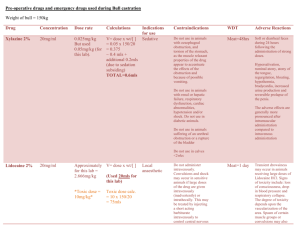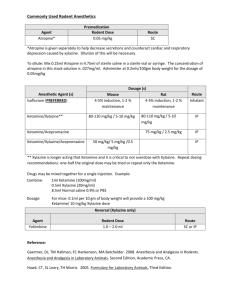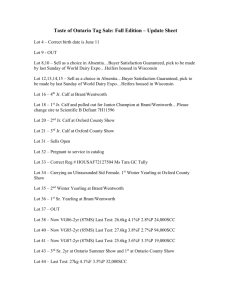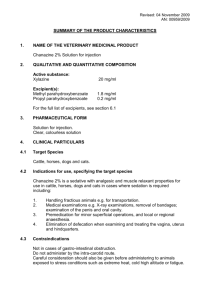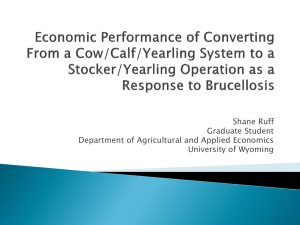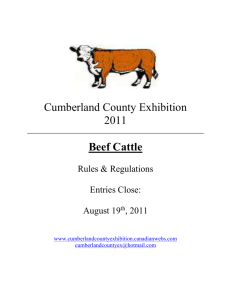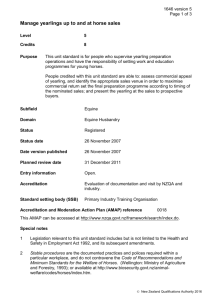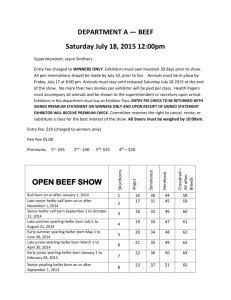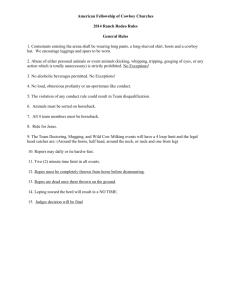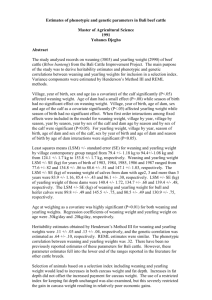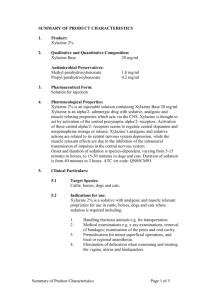LAS - drug table - lab4
advertisement
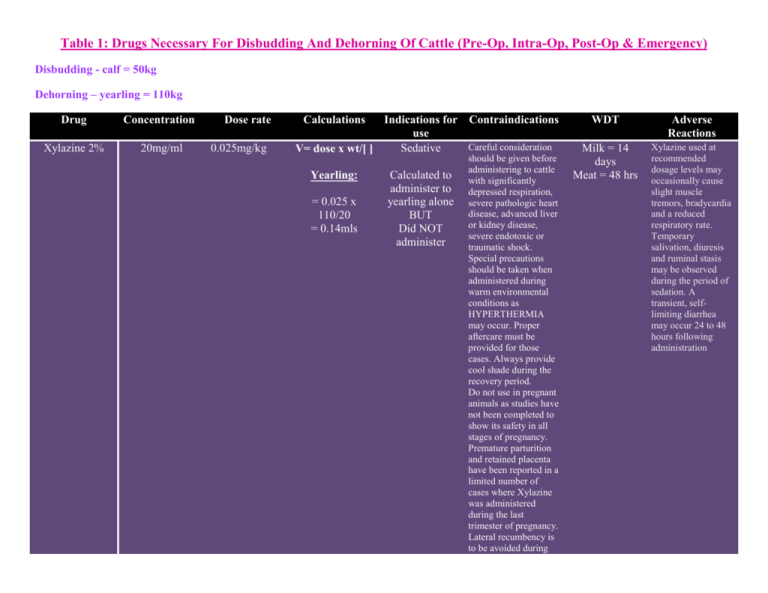
Table 1: Drugs Necessary For Disbudding And Dehorning Of Cattle (Pre-Op, Intra-Op, Post-Op & Emergency) Disbudding - calf = 50kg Dehorning – yearling = 110kg Drug Concentration Xylazine 2% 20mg/ml Dose rate 0.025mg/kg Calculations Indications for Contraindications use Careful consideration Sedative V= dose x wt/[ ] Yearling: = 0.025 x 110/20 = 0.14mls Calculated to administer to yearling alone BUT Did NOT administer should be given before administering to cattle with significantly depressed respiration, severe pathologic heart disease, advanced liver or kidney disease, severe endotoxic or traumatic shock. Special precautions should be taken when administered during warm environmental conditions as HYPERTHERMIA may occur. Proper aftercare must be provided for those cases. Always provide cool shade during the recovery period. Do not use in pregnant animals as studies have not been completed to show its safety in all stages of pregnancy. Premature parturition and retained placenta have been reported in a limited number of cases where Xylazine was administered during the last trimester of pregnancy. Lateral recumbency is to be avoided during WDT Adverse Reactions Milk = 14 days Meat = 48 hrs Xylazine used at recommended dosage levels may occasionally cause slight muscle tremors, bradycardia and a reduced respiratory rate. Temporary salivation, diuresis and ruminal stasis may be observed during the period of sedation. A transient, selflimiting diarrhea may occur 24 to 48 hours following administration recovery due to increasing the possibilities of bloat, regurgitation and/or aspiration. Sternal recumbency is the appropriate recovery position. A 24-hour fast prior to injection will also reduce the incidence of bloat. Do not use Xylazine in conjunction with tranquilizers. Following the use of Xylazine, veterinarians and attendants should continue to use care and appropriate handling techniques, since conscious animals, although sedated, are capable of inflicting personal injury. Lidocaine 2% 20mg/ml 0.2mg/kg YEARLING: 10mls/site = TOTAL=20mls Toxic Dose: 10mg/kg = 10 x 110/20 = 55mls CALF: 5mls/site = TOTAL=10mls Toxic Dose: 10mg/kg Local anaesthetic Do not administer intravenously. Convulsions and shock may occur in sensitive animals if large doses of the drug are given intravenously (inadvertently) or intrathecally. This may be treated by injecting a short acting barbiturate intravenously to control central nervous system stimulation and immediately administering artificial respiration or oxygen. Milk = 24hrs Meat = 1 day Transient drowsiness may occur in animals receiving large doses of Lidocaine HCl. Signs of toxicity include: loss of consciousness, drop in blood pressure and respiratory collapse. The degree of toxicity depends upon the vascularization of the area. Spasm of certain muscle groups or convulsions may also occur. Treatment for toxicity is as follows: lowered head, artificial respiration, oxygen and I.V. pressor agents. Convulsions and spasm are controlled by means of small amounts of I.V. ultra shortacting barbiturates. = 10 x 50/20 = 25mls Flunixin Meglumine (Banamine) 50mg/ml 1.1mg/kg YEARLING: 1.1 x 110/50 = 2.42mls CALF: 1.1 x 50/50 = 1.1mls Penstrep 200,000 IU/ml 20,000 IU/kg YEARLING: 20,000 x 110/200,000 = 11mls Nitrofurazone - - CALF EMERGENCY DRUGS ------------------- Pre-emptive analgesia Post-op for 3 days antibiotic Topical antibiotic ------------------- -------------------- ------------------- Do not administer intra-arterially. Inadvertent intraarterial injection may cause adverse reactions. Do not use in cattle showing hypersensitivity to flunixin meglumine. The drug is contraindicated in animals with hepatic disease, renal and cardiovascular impairment, gastrointestinal ulceration and/or platelet disorders. It is also contraindicated in dehydrated animals. Contraindicated in known cases of hypersensitivity to penicillins. Meat = 4 days 30 Days ----------------------- Do not use in bulls intended for breeding as reproductive effects of Flunixin Injection in this class of cattle have not been investigated. During clinical studies no significant side effects were reported when the drug was injected slowly. In cattle, a temporary head thrashing can occur if the drug is injected too rapidly. Carcinogenic ------------------ --------------------- Tolazoline 100mg/ml Atropine 0.54mg/ml 2 x Xylazine dose, i.e. 0.05mls (for this lab) 0.04mg/kg 0.05 x 110/100 = 0.055mls Xylazine reversal None for food animals YEARLING: 0.04 x 110/0.54 = 8.15mls Use if bradycardic (<30bpm) Milk = 3 days Meat = 14 days Anaphylactic reactions No WDT CALF: 0.04 x 50/0.54 = 3.7mls Epinephrine 1mg/ml 0.02mg/kg YEARLING: 0.02 x 110/1 = 2.2mls CALF: 0.02 x 50/1 = 1ml
